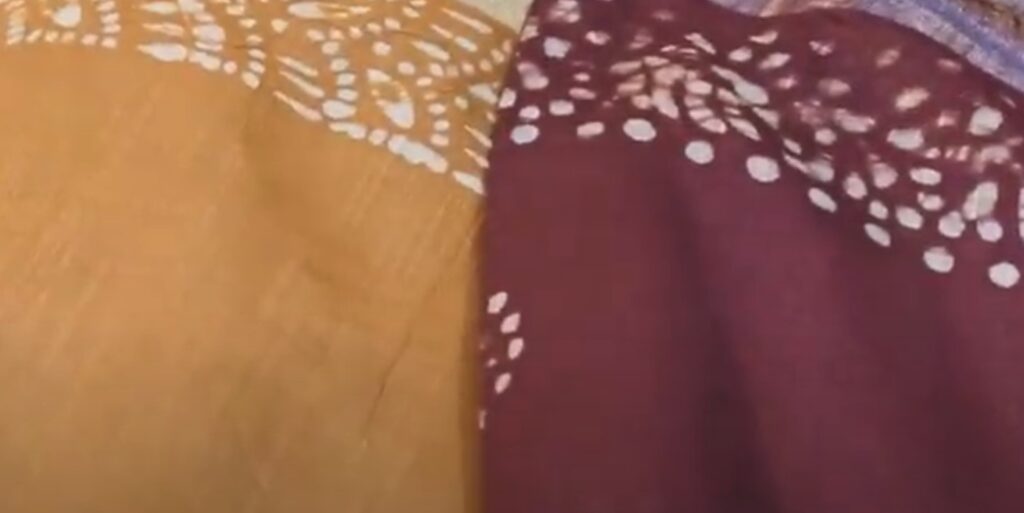In Batik art wax is used to create images on a piece of fabric. The art of Batik is appreciated all over the world. The name ‘Batik’ comes from ‘Ambatik’ which means a pattern of dots or broken lines drawn on a piece of cloth using wax. Ambatik can be broken into two words ‘amba’ which means large or wide and ‘tik’ which means ‘dot’. Some piece of clothing has also been seen in other countries like China, Turkey, and Japan. The origin of Batik art is unknown.

Batik Art is also known as the Indonesian technique of wax-resist dyeing. Java has a long history of Batik art. It was affected by the diversity of cultures in and outside the country. Batik art holds a special place in the hearts of Indonesia people. They wear it on casual and formal occasions. It is also a part of their rituals, ceremonies and other festivities.
India also has a history of Batik saree. There are ancient tapestries with Batik art on them. These tapestries are very old which shows that art existed in India too.
On 2nd October 2009, UNESCO recognized Batik art Masterpiece of Oral and Intangible Heritage of Humanity from Indonesia. The aim behind it was to promote and preserve Batik art. The step encouraged the People of Indonesia to keep doing the artwork.
History of Batik Art
The roots of Batik art goes back to the 1st century AD. Art started declining in India during British rule due to industrialization and a lack of encouragement from the government.
By the 20th century, Batik attracted a large crowd towards it which fixed its place on the syllabus of the University of Shanti Niketan, Kolkata. Later on, it received more acknowledgement and more people decided to move on with this art. Small startups started which populated Batik art all over the world.
Process of Batik Art
The process of creating Batik art of a piece of clothing is done in three steps. First wax, then dying and then removing the excess wax from the cloth.
First, a rough design is made on the cloth to determine the lines. Then the wax will be used to create a pattern using an already existing pattern. After the wax is set cloth is dyed in various colours. To remove excess wax a sharp object is used to scrape it off or the cloth is boiled in the water where it will melt away. The area covered with wax contains its natural colour whereas other parts are dyed with various colours. It provides the cloth with beautiful contrast patterns. The Batik art sarees are cheap compared to other art sarees because it is easy to do. It does not require 3-4 artisans on a piece of clothing at a time to complete it.
Fabric Used for Batik Saree
Traditionally silk or cotton fabrics are used to make Batik art. Both fabrics are strong enough to bear the heat and wax. If the fabric is not strong enough it can melt. The wax is applied hot on the fabric so that it stays. Bit it should not be so hot that it ruins the cloth.
Natural Colors
To dye the cloth natural colours are derived from natural resources. The brown colour is extracted from bark, the green colour is extracted from leaves and other colours are extracted from flowers. The yellow colour was made from turmeric, orange and red were made from henna.
Methods of making Batik Art
Woodblock is used to make big patterns on the fabric. For thin lines pen or brush are used.
- Hand Printing Method: In this method, the entire process is done using hands. Artisans use Kalamkari art to draw patterns and separate the wax.
- Screen Printing Method: In screen printing methods machines are used to draw a pattern. A stencil is used to draw more defined patterns.
- The Splash Method: The splash method is in which wax is thrown on the fabric in a random pattern. These random patterns come out very beautifully after the dye.
Colour Theme of Batik Art
It is believed that the main colours brown, indigo and white used in Batik art represent the three Hindu gods Brahma, Vishnu, and Mahesh (Shiva). Brown and Indigo are used majorly because these are the two natural colours that are easily available.
Batik Sarees
Cotton Batik sarees are cheaper than Silk Bartik saree because of fabric. Silk is expensive than cotton. But if you like the art no matter what saree you get it will still be beautiful. A cotton batik saree ranges from 1000rs to 2000rs where a silk saree ranges from Rs 5000 to 15000. Of course, the range can go up and down depending upon where you are buying from and if the fabrics are real. Nowadays many synthetic fabrics are available that are cheap. Synthetic fabric sarees are cheaper than natural fibre sarees because they are not authentic and are made using chemicals.
Batik sarees are made in Rajasthan, Gujarat, and Bengal. They are growing in other states as well but these are some of the major centres of Batik sarees. Along with sarees, you can also see suits and dress material in the market.
